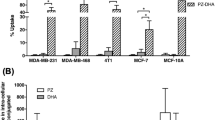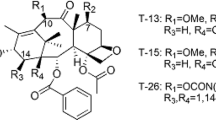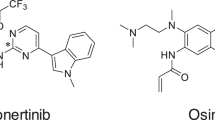Abstract
2,3,5-Trimethyl-6-(3-pyridylmethyl)1,4-benzoquinone (CV-6504) is an effective inhibitor of the growth of established murine adenocarcinomas (MACs) and is shortly to enter clinical investigation. When administered to mice bearing the MAC16 tumour, CV-6504 rapidly disappeared from the plasma and tissues and there was an accumulation of the sulphate and glucuronide metabolites. After 24 h, the concentration of free CV-6504 in the tumour (3.3 microM) was higher than that in the liver (0.24 microM) and equal to the IC50 value for the inhibition of the growth of MAC16 cells in vitro (3 microM). The concentration of glucuronide and sulphate metabolites in both tumour and liver decreased with time. Both the MAC16 tumour and the liver possessed similar beta-glucuronidase activity, which could account for the accumulation of free CV-6504. Although the sulphate and glucuronide conjugates of CV-6504 were ineffective inhibitors of the growth of MAC13 cells in vitro at concentrations up to 100 microM, in vivo at a concentration of 50 mg kg-1 day-1 the conjugates produced a similar anti-tumour effect to CV-6504 at a concentration of 5 mg kg-1 day-1. The MAC13 tumour possessed both beta-glucuronidase and sulphatase activity capable of converting the sulphate and glucuronide conjugates to free CV-6504. Using MAC13 cells ex vivo, CV-6504 inhibited conversion of arachidonic acid to 5-, 12- and 15-hydroxyeicosatetraenoic acids (HETE). The percentage reduction in formation of 12- and 15-HETE exceeded that of 5-HETE. Inhibition of HETE formation may be responsible for the anti-tumour activity of CV-6504.
This is a preview of subscription content, access via your institution
Access options
Subscribe to this journal
Receive 24 print issues and online access
$259.00 per year
only $10.79 per issue
Buy this article
- Purchase on Springer Link
- Instant access to full article PDF
Prices may be subject to local taxes which are calculated during checkout
Similar content being viewed by others
Author information
Authors and Affiliations
Rights and permissions
About this article
Cite this article
Hussey, H., Tisdale, M. Metabolism and pharmacokinetics of the anti-tumour agent 2,3,5-trimethyl-6-(3-pyridylmethyl)1,4-benzoquinone (CV-6504). Br J Cancer 74, 1349–1353 (1996). https://doi.org/10.1038/bjc.1996.548
Issue Date:
DOI: https://doi.org/10.1038/bjc.1996.548



